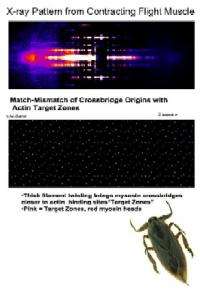The molecular mechanism of stretch activation in insect muscle

(PhysOrg.com) -- Flying insects are among the most successful species on our planet. Flight is very metabolically demanding and many insects have found a clever way to reduce energy costs in their flight muscles by employing a process called “stretch activation,” whereby nervous stimulation is just enough to maintain a constant low level of calcium and the muscles are “turned on” when they are stretched by antagonistic muscles. Stretch activation has been recognized since the 1960s as an interesting and physiologically important phenomenon, but a mechanistic explanation has been elusive.
Now, research at the Biophysics Collaborative Access Team (Bio-CAT) synchrotron x-ray facility at the U.S. Department of Energy’s Advanced Photon Source (APS) at Argonne provides another, important step toward a full explanation of stretch activation, which also plays an important role in mammalian cardiac expansion and contraction.
How stretch activation works in the heart is unknown. As contractions propagate through the heart, the contraction of one piece of muscle tissue stretches adjacent muscle, thereby activating it. The end result is a very strong contraction at the end of systole aiding cardiac ejection. Heart muscle is much less organized structurally than insect muscle and is thus much harder to study using current biophysical methods than is the nearly crystalline insect muscle system. Furthermore, diffraction patterns from insect muscle have readily identifiable diffraction signatures, lacking in mammalian muscle, that indicate force-producing crossbridge binding to actin binding sites. The insect muscle presents, therefore, an ideal model system to study crossbridge action and its regulation.
The experiments carried out at the Bio-CAT are the result of collaboration between the groups of Michael Reedy at Duke University, Thomas Irving at IIT, and researchers from Florida State University, The Scripps Research Institute, and the European Molecular Biology Laboratory. The experimenters used the Pilatus 100K detector newly available at Bio-CAT to collect two-dimensional x-ray diffraction movies (16-ms time resolution, or 32 frames per wing-beat cycle) of isolated flight muscle from the waterbug Lethocerus indicus during sinusoidal length oscillations that mimic the wing-beat cycle in vivo.
Full analysis of all the diffraction features will take some time but enough is now known to propose a comprehensive, self-consistent structural model for stretch activation. There appear to be connections between the thick and thin filaments, at the level of the troponins, proteins that normally turn on and off the thin filament by binding calcium. Providing there is some calcium present, these connections can turn on the thin filament by transmitting strain from the thick filaments to the troponins. These long-lived troponin connections appear to consist of the same sort of myosin heads that bind to actin at so-called target zones elsewhere on the thin filament to generate force. Strain in troponin appears to alter its interaction with another protein tropomyosin, allowing this long actin-blocking protein to move so as to open the binding sites on actin to accept the force producing myosin heads.
Meanwhile, the thick myosin containing filaments are twisting as a response to passive stretch at the same time that the actin-containing thin filaments are elongating in response to the same stretch. The result is more myosin heads brought within range of target zones during muscle stretch so that they bind actin more quickly and generate force more efficiently.
These new data and this new model bring together many ideas from many places to provide a testable model for stretch activation.
The Reedy group has been collaborating with the Irving group for more than 18 years and this project has been a major motivator for many of the technical developments in fiber diffraction at the Bio-CAT facility. The present experiment, providing a solution to a long standing puzzle, has raised much excitement in the muscle biophysics community. Ken Holmes of Heidelberg University, who did the very first synchrotron diffraction experiment of any kind back in 1970, said recently that Reedy’s group has finally accomplished the same insect muscle experiment that Rosenbaum, Holmes, and Witz hoped to perform when they innovated use of synchrotron radiation for x-ray diffraction 40 years ago (Nature 230, 434 [1971]).
More information: Robert J. Perz-Edwards, Thomas C. Irving, Bruce A. J. Baumann, David Gore, Daniel C. Hutchinson, Uroš Kržič, Rebecca L. Porter, Andrew B. Ward, Michael K. Reedy, “Turning muscles on: stretch triggers tropomyosin movement in insect flight muscles,” “X-ray diffraction evidence for myosin-troponin connections and tropomyosin movement during stretch activation of insect flight muscle,” Proce. Nat. Acad. Sci. USA, published online before print, December 9, 2010. DOI:10.1073/pnas.1014599107
Provided by Argonne National Laboratory















